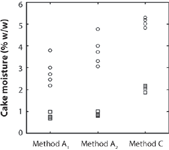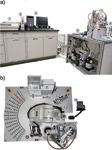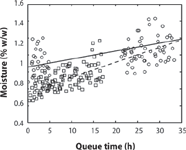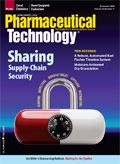A Robust, Automated Karl Fischer Titration System
The authors developed a robust, automated system to conduct Karl Fischer moisture assays for lyophilized products.
Karl Fischer titration is one of the few assay techniques recognized by the US Food and Drug Administration for the determination of residual moisture in lyophilized pharmaceutical products (1). Because the iodine–water reaction is specific and quantitative, this technique provides high accuracy and precision. However, conventional Karl Fischer titration is not considered a high-throughput assay and requires significant manual intervention. This test can present a challenge when many samples must be analyzed in a short time. Furthermore, most lyophilized products are hygroscopic and must be processed promptly after removal from the primary container.
The few off-the-shelf automated setups offered by Karl Fischer titrator vendors use a carousel onto which several samples, preweighed in individual containers, can be loaded. The titration is performed directly in these containers as the carousel rotates each sample through the titration station. Unfortunately, no satisfactory means has been devised for sealing the samples from the environment while they await analysis. Hence, hygroscopic lyophilizates cannot be processed on these types of automated titrators.
This article describes the authors' development of a reliable system for performing Karl Fischer titration automatically on numerous samples. It explains the rationale for selecting instrumentation and discusses sample-preparation strategies that affect the overall design of the automated system.
Titration-instrument selection
The Karl Fischer titrator is the heart of an automated moisture-analysis system. First, a sample is loaded into a conditioned water-free titration cell. Iodine (I2) from the titrant is then metered in and reacts with water present in the sample. The titration end point occurs when all the water in the sample has reacted away. The end point is determined by detecting free iodine at a double-pin platinum electrode. Because this reaction is quantitative, the amount of water can be obtained by measuring the amount of titrant required to return the titration cell to an anhydrous state. The literature contains a comprehensive treatise about Karl Fischer titration (2). Two types of instruments are available to perform titration: coulometric titrators and volumetric titrators.
Coulometric titrators. Coulometric titrators generate iodine by the in situ electrochemical oxidation of iodide (I–) contained in the reagents. The total amount of iodine generated is proportional to the total charge passed in the electrochemical cell. This allows for sensitive detection of water: from ~1 to ~50,000 ppm (5% w/w).
Volumetric titrator. In a volumetric titrator, the iodine is already present in the titrant, and the titrator simply measures the volume of reagent dispensed into the cell from a precision burette. Sacrificing sensitivity for range, volumetric titrators can measure water content from ~0.1 to 100 % (w/w).
For the current application, the high sensitivity of Coulometric titration was not necessary, but it was desirable to be able to analyze samples with high moisture content (>5 wt %). Hence, the authors decided that a volumetric Karl Fischer titrator was more suitable.
Any titrator that allows operations to be controlled from an RS-232 interface could have been selected. The authors considered only Metrohm (Herisau, Switzerland) and Mettler–Toledo (Greifensee, Switzerland) instruments, however, because these two companies' titrators were already used and supported at their site. When the project began, Metrohm offered the 700 series of titrators, which included models 784, 787, and 795. The models had similar capabilities, but the 784 and 795 provided more flexible interconnectivity with optional accessories and additional internal memory for method storage. Mettler–Toledo offered the DL31 and DL38 titrators; the latter model had more internal memory and slightly more data-processing functionality. No significant operational differences existed between these five instruments for the authors' application because all data treatment was intended to be performed on a separate computer. Ultimately, the authors selected the Mettler DL31 because its setup included a higher-volume titration cell with a larger sample port than the Metrohm models. In addition, the Mettler titrator's stir-bar driver could be controlled remotely.
Sample-preparation techniques
All of Genentech's (South San Francisco, CA) lyophilized products are packaged in glass vials. Many configurations, spanning various compositions, fill volumes, and vial sizes, exist, however. The authors considered the techniques as outlined below for preparing samples.
Method A: extraction in the product vial. Mettler-Toledo recommends this technique for handling freeze-dried substances (3). The procedure calls for injecting a known amount of anhydrous solvent (e.g., methanol or other primary alcohols) directly into the unopened sample vial and allowing time for water to be extracted into the solvent. Agitation or sonication can expedite the extraction. An aliquot of the extract is then withdrawn from the sample vial and introduced into the titration cell for analysis.
Method B: drying oven. In this technique, the sample vial is placed into a small oven and heated to desorb the moisture from the contents. An inert, dry carrier gas is fed into the vial, and the effluent is introduced into the titration cell for analysis. The oven temperature setting and total desorption time often depend on the sample. Higher temperatures allow for faster water desorption but can cause the decomposition of certain substances such as sugars, which can yield erroneous moisture results (2).
Method C: direct extraction of crushed sample in titration cell. Genentech has traditionally used this technique. The product vial is uncapped, and the contents are crushed inside the vial using a smooth metal rod. A known amount of powdered sample is then transferred directly into the titration vessel for analysis.
All of the authors' historical data were collected using Method C. The following study was undertaken to determine the comparability between Method A and Method C only. The experimental setup for Method B was not available. Furthermore, many of Genentech's lyophilized products are formulated with large amounts (e.g., as high as 85% wt.) of sugars, which limits drying ovens to low temperatures. Other products contain high amounts of salts and require high oven temperature for efficient moisture desorption. Because it was undesirable to develop a separate method for each product, the authors did not use the moisture-analysis technique that relies on drying ovens.
A Mettler-Toledo DL31 volumetric Karl Fischer titrator with a one-component Hydranal Composite 2 titrant was used in all cases. Sodium tartrate dihydrate was used as the standard to determine the reagent titer at the beginning of each day, as recommended by the instrument manufacturer.
The authors used active lyophilized product configured as a 0.88-mL fill volume in 5-cm3 vials in the study. Two sets of samples, spanning the typical range of moisture normally observed for this product (i.e., 0.5–5% wt.), were tested.
The authors investigated the following two extraction schemes for Method A:
I Introduction of anhydrous methanol into the product vial, 5-min sonication, withdrawal of an aliquot and analysis. This is the instrument manufacturer's recommended procedure.
II Introduction of anhydrous methanol into the product vial, 5-min sonication, 5-min standing, an additional 5-min sonication, withdrawal of an aliquot, and analysis.
Figure 1 summarizes the results for these experiments. For consistency with historical data, water content is reported as weight percent moisture of the lyophilized product cake. To calculate weight percent moisture values for Method A, the sample vials had to be weighed before extraction, emptied after extraction, cleaned, dried, and reweighed to obtain the actual freeze-dried cake's mass. These extra steps added complexity and lengthened the overall analysis time. Method B would also require following the same procedure.

Figure 1: Comparison between extraction methods. Squares represent low-moisture samples, and circles represent high-moisture samples. (IMAGE IS COURTESY OF PHILIPPE LAM)
Comparing results from the two methods, it is clear that Scheme II of Method A extracted more water than the recommended Scheme I, suggesting that Scheme I was not able to fully extract the water from the sample. Yet it is unclear whether Scheme II achieved complete extraction.
Neither scheme of Method A extracted as much water from the samples as Method C. The difference is more pronounced for high-moisture samples (see the circles in Figure 1), where Method C also yielded less scatter in the data. However, Method C may be influenced by the level of relative humidity in the room because the crushed lyophilized cake is briefly exposed to ambient conditions. Hence, the true moisture content of a sample may lie between the values given by Methods A and C.
The authors attempted to estimate the tendency for moisture uptake during sample preparation for Method C by leaving uncapped vials on the bench for 2–3 min after the contents were crushed. The difference in moisture content between these dwelled samples and ones that were analyzed immediately after pulverization was typically less than 0.1% (w/w). It is not possible to know the absolute amount of environmental moisture introduced during the entire sequence of operation, but Method C tends to err on the safer side because it may overestimate samples' water content.
Although Method A offers the advantage of protecting the sample from direct handling and exposure to ambient conditions, the additional steps required after extraction are undesirable. Furthermore, products contained in large containers such as 50–100-cm3 vials will require longer extraction time because the water has a longer diffusion path. Method A also requires large volumes of solvent for the extraction, thus compounding waste-disposal problems. For these reasons, the authors decided to implement Method C in the automated system.
The authors also considered fully automating sample preparation, including uncapping, crushing, and dispensing of the lyophilized cake. Such a system, however, would need to handle vials sizes from 5 to 100 cm3 and to consistently pulverize lyophilized product cake of various consistencies and various heights. These capabilities would entail a complex and cost-prohibitive setup for sample preparation alone. Hence, the authors simply elected to prepare samples manually, as is current practice. A trained analyst can perform these operations in less than 2 min per sample.
Automated-system design and construction
Sequence of operation. Given the requirements discussed above, the automated system should operate according to the following sequence:
- The analyst prepares the sample according to Method C. An amount (e.g., 50–150 mg) of crushed lyophilizate is dispensed into a standard centrifuge tube, which is then tightly capped. The tube is placed into a sample rack. Several samples can be prepared and loaded into the system.
- The automated system retrieves a sample tube from the rack and transfers it to a balance that records the weight.
- The sample tube is placed in a decapping station, and the tube cap is removed.
- The sample is dispensed into the titration cell. Titration is initiated.
- The sample tube is recapped and reweighed. The actual sample mass delivered to the titration cell is determined, and the sample tube is discarded.
- The titration result is returned, and the titration cell is cleaned if necessary after a prespecified number of titrations.
- The cycle repeats from step 2.
This sequence is basically the same as that of the manual technique. A robotic system is needed to shuttle the sample between the rack, balance, and titrator. The titration of the sample remains the rate-limiting step, so the total analysis time is comparable to that of a fully manual operation. Titration times typically range from a few minutes to more than 10 min, depending on the composition and moisture level of the sample. The benefit of an automated setup, however, is the ability to perform unattended analysis once the samples have been loaded into the system.
System construction. To minimize costs, the authors incorporated as many off-the-shelf components as possible. A Mettler-Toledo XP 204 balance was selected because this model offers RS-232 serial connectivity, motorized draft doors, and a removable front control panel. The latter feature is important because removing the front panel prevents the accidental activation of a balance operation during a run.
The DL31 titrator includes a small vacuum pump for withdrawing and dispensing solvent from the titration cell. However, that setup is not sufficiently powerful to ensure the full removal of the cell contents and accurate dispensing of solvent. Hence, the automated system performs the fluid handling (e.g., waste removal and solvent dispensing) with a pair of Masterflex L/S computer-compatible peristaltic pumps that also offer RS-232 serial connectivity. The fluid-path contact surface includes PTFE and chemical-resistant Masterflex Tygon Chemical tubing.
The samples are shuttled between the various stations by a Mitsubishi RV-2AJ-511 five-axis industrial robot arm equipped with a set of custom triposition grippers. This robot has a proven track record in industrial settings, is reliable, is widely used, and also is controlled through RS-232 serial communication. Furthermore, the robot arm controller provides several digital input–output lines that can power solenoid valves, thus permitting the actuation of pneumatic cylinders for the decapping station and the titration cell cap.
AB Controls (Irvine, CA) integrated all the components and placed them aboard a compact, custom-fabricated aluminum frame. The Focus software, AB Controls's automation and robotics application, was customized to control all operations from a standard computer equipped with the Windows operating system and a multiport serial-communication card.
Figure 2 shows the entire setup, including the sample rack, which holds a total of 105 samples contained in standard 15-cm3 screw-cap polypropylene centrifuge tubes. The system was designed primarily for robustness and reduces the potential for operator and hardware errors by minimizing the number and complexity of operational steps. In addition, numerous step-completion verification and safety checks are included in the run sequence. For example, before starting a run, the system verifies that the balance chamber is empty to prevent placing a sample tube in a location that is already occupied. At the decapping station, the system ensures that the cap has been removed from the sample tube before attempting to dispense the sample into the titration cell.

Figure 2: Automated Karl Fischer titration system components. Side view (a) and top view (b) of the titration deck. The footprint is approximately 95 x 110 cm. Components include the result line printer (1), UPS for entire robotic system (2), Windows XP computer (3), Mitsubishi robot controller (4), sample tube rack that includes 105 positions (5), titration-cell pneumatic sealing mechanism assembly (6), Mitsubishi robot arm (7), MettlerâToledo XP analytical balance (8), MettlerâToledo DL 31 volumetric Karl Fischer titrator (9), solvent-delivery and waste-removal peristaltic pumps (10) and (11), waste bottle (12), solvent bottle (13), pneumatic decapping station (14), cap holder (15), spent-sample tube chute to trash bin (16), hydranal reagent bottle and holder (17), and ionizer for static charge control (18). (IMAGE IS COURTESY OF PHILIPPE LAM)
The instrument control software offers the users a limited number of choices. The manual "Control" screen allows the operator to activate certain functions such as the titration-cell wash routine, open and close the titration-cell cap, move the robot arm grippers, control the balance door, and operate the decapping station gripper. The operator thus has sufficient control to handle routine maintenance such as cleaning the titration cell and removing sample tubes that were left in the system after a critical error or an emergency stop. Advanced functions such as control of the robot-arm movements are disabled for safety reasons and can only be accessed through a password-protected administrator login.
The "Run Standards" screen allows the operator to perform titer determination using sodium tartrate. The raw data (volume of titrant dispensed) is obtained from the titrator, the sample mass is obtained from the balance and the titer (mg H2O/mL KF reagent) is calculated and stored by the Focus software. Here, a minimum of three replicates are required. The average value is used for all subsequent sample moisture determination.
The "Run Sample" screen allow users to enter the total number of samples to be analyzed and the number of titrations to be performed before the titration cell is washed. These two user-input parameters are the only ones that directly affect system operation. No product-specific methods exist. All samples are handled and analyzed in the same manner. After each moisture determination, the result is sent to the computer and immediately printed on the attached line printer. To simplify system validation, the authors decided not to include the optional 21 CFR Part 11: Electronic Records, Electronic Signature feature, but this functionality could be added in a future software revision if needed.
The "Mock Run" screen is identical to the "Run Sample" screen, with exception that no titration is performed. This mode is used for system demonstration and training purposes.
System testing
The system was subjected to comprehensive tests, including hardware error checking and recovery. No major difficulties were encountered. Operational testing was simplified by the limited number of user input parameters. This section presents the results from the most relevant studies: the moisture determination of active hygroscopic freeze-dried product from a fully loaded sample rack.
For these studies, the sample queue times (i.e., the time the samples were on the rack awaiting analysis) were recorded. Figure 3 summarizes the results for two sets of samples consisting of two batches of active material lyophilized in 50-cm3 vials. For the second set, analysis was paused after 4.5 h and resumed 17 h later to increase the queue time.

Figure 3: The effect of queue time on sample moisture. The squares and dashed line represent Sample Set 1. The circles and solid line represent Sample Set 2. (IMAGE IS COURTESY OF PHILIPPE LAM)
The data show that, for this product, the sample moisture increases in a linear way as a function of queue time. The increase suggests that the samples absorb environmental moisture, most likely from diffusion though the centrifuge tube wall or the cap closure seal. The absolute overhead moisture present in a 15-mL sample tube under typical laboratory ambient conditions of 21 °C and 50 ± 15% relative humidity is approximately 1.4 × 10-4 mg, an insignificant amount. The moisture-ingress rates for the two sets of samples are 0.018 wt%/h and 0.0095 wt %/h, respectively. This behavior is expected and results from the sample-preparation method selected. Although this small amount of moisture ingress seems to be a shortfall, in practice, analysts prepare 10–20 samples at a time, and samples are added only after most of the initial samples have been tested. Hence, the queue time is typically only a few hours. This minor limitation was deemed an acceptable tradeoff for the convenience afforded by an automated system.
Conclusion
The authors have demonstrated a system that can perform Karl Fischer titration unattended. This instrument is fully validated for use in activities such as lyophilization-cycle development, technology transfer between various manufacturing sites, and manufacturing-discrepancy investigations.
Although the platform upon which this system is based is highly customizable and versatile, the authors decided to sacrifice functionality in favor of robustness. As a result, this instrument requires minimal training for operator proficiency, requires little maintenance, and has seen heavy use. Overall, the instrument it has been a cost-effective tool that saved labor, time, and money.
Acknowledgments
The authors would like to thank M. Joyce, D. Lawrence, D. Mehrwein, C. Buruel, K. Kifle, A. Gonzales, and P. Hearne for suggestions and help with system validation.
Philippe Lam* is a senior engineer for pharmaceutical process research and development at Genentech, 1 DNA Way, South San Francisco, CA 94080, tel. 650.225.7002, fax 650.225.3616, plam@gene.com. Mike Nariman is a senior systems architect at AB Controls.
*To whom all correspondence should be addressed.
Submitted: Dec. 4, 2008. Accepted: Feb. 19, 2009.
What would you do differently? Submit your comments about this paper in the space below.

References
1. FDA, Guideline for the Determination of Residual Moisture in Dried Biological Products (Rockville, MD, Jan. 1990).
2. E. Scholz, Karl Fischer Titration, (Springer-Verlag, Berlin, 1984).
3. Mettler–Toledo, "Fundamentals of the Volumetric Karl Fischer Titration," (Mettler–Toledo, Columbus, OH, 1999), p. 42.

Pharmaceutical Tariffs Are Imminent: How Industry is Bracing for Impact
April 16th 2025On April 14, 2025, the Trump Administration launched a national security-driven investigation into pharmaceuticals, a move that will likely result in tariffs being placed on pharmaceutical drugs, ingredients, and other components that are imported from outside of the United States.
Drug Solutions Podcast: A Closer Look at mRNA in Oncology and Vaccines
April 30th 2024In this episode fo the Drug Solutions Podcast, etherna’s vice-president of Technology and Innovation, Stefaan De Koker, discusses the merits and challenges of using mRNA as the foundation for therapeutics in oncology as well as for vaccines.